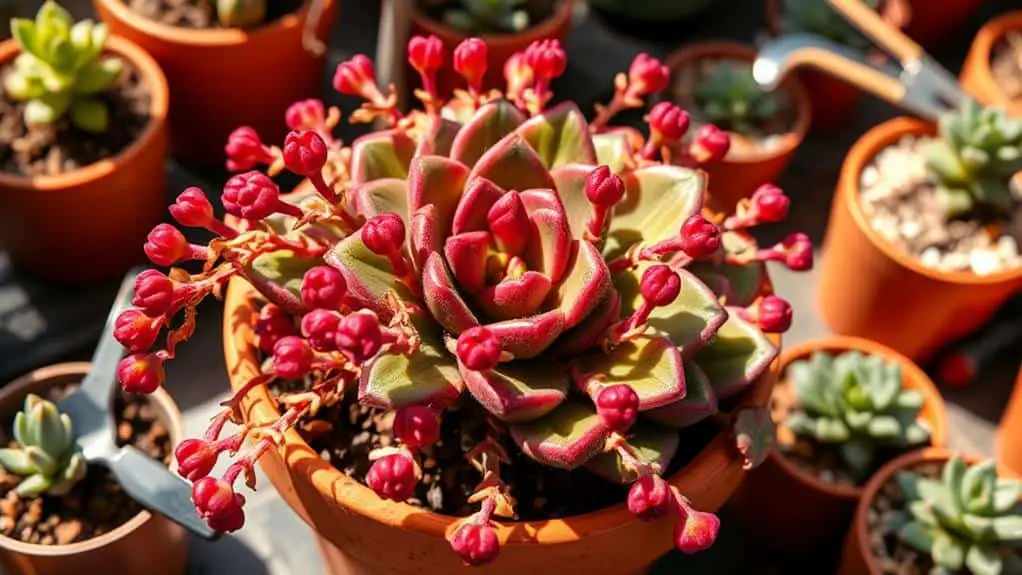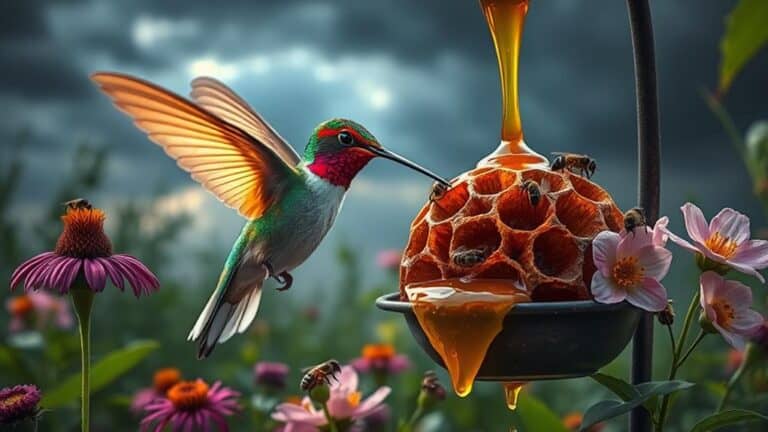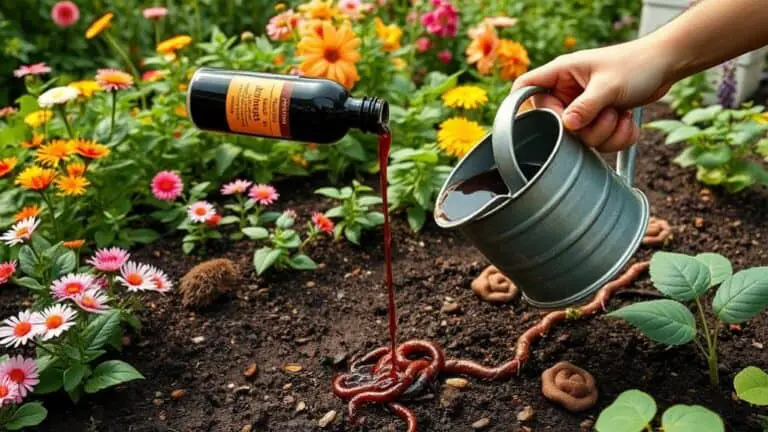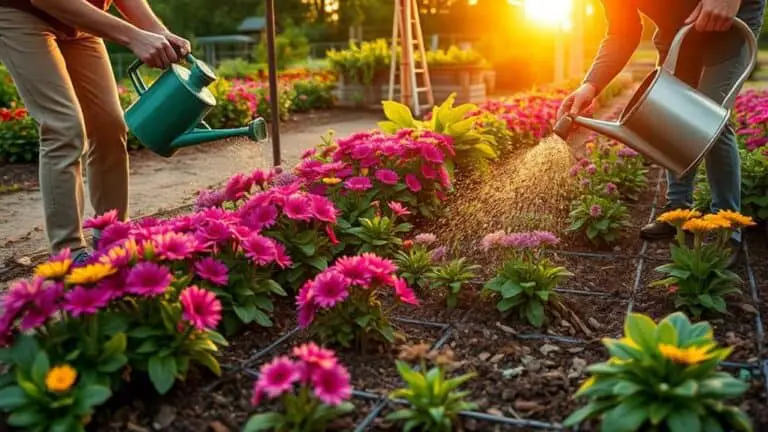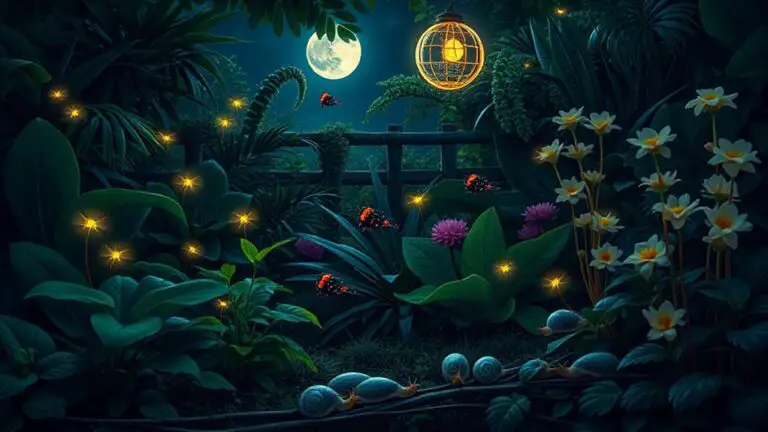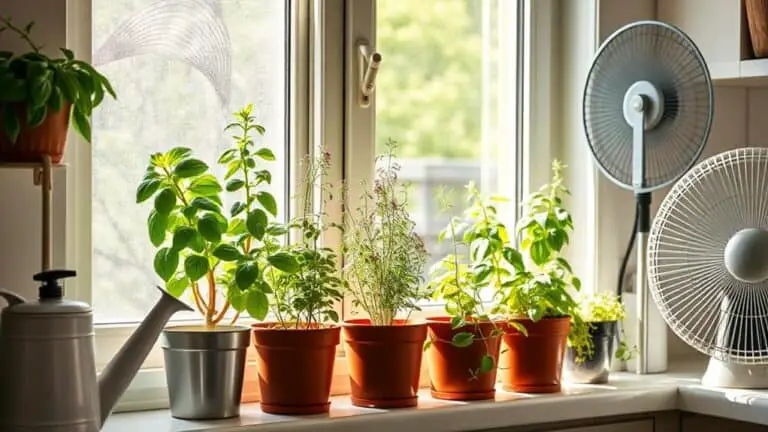How To Grow And Care For A Ruby Necklace Succulent
When it comes to growing and caring for a Ruby Necklace succulent, I've found that a few key factors make all the difference. You'll want to give it bright, direct sunlight and keep it in an environment with temperatures ranging from 60°F to 80°F. Watering is essential—thoroughly soak the soil every 2-3 weeks during the growing season, letting it dry out completely in between. During winter, reduce watering. But there's more to take into account, from soil type to pest control, that can guarantee your Ruby Necklace thrives. Curious about those details? Let's explore further.
Overview and Characteristics
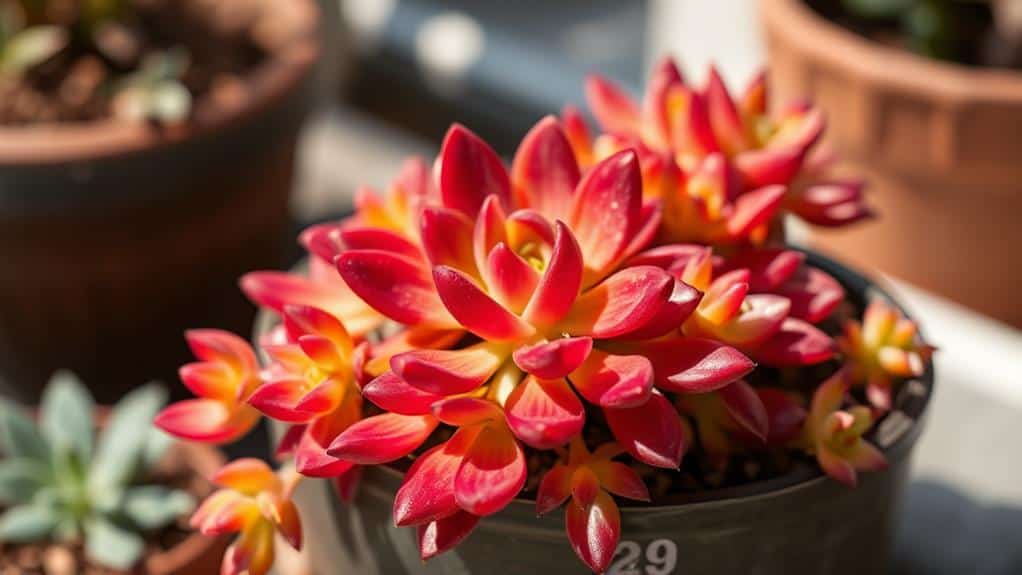
The Ruby Necklace, scientifically known as Othonna capensis, is a fascinating succulent that dazzles with its vibrant ruby-red, bean-shaped leaves and trailing growth habit.
Native to South Africa, the Ruby Necklace thrives in arid conditions and is perfect for those who prefer low-maintenance plants. It grows quickly, making it ideal for hanging baskets and ground cover.
Under optimal conditions, its leaves turn a striking reddish-purple, while in less light, they stay green and might grow leggy. This succulent also produces delicate yellow flowers throughout the year, adding even more visual interest.
It typically grows between 2-12 inches long but can extend up to 3 feet, making it a versatile addition to any garden.
Light Requirements
Understanding the light requirements of the Ruby Necklace succulent is key to maintaining its vibrant colors and overall health. This plant loves several hours of bright, direct sunlight daily, so placing it near a south or west-facing window is ideal.
In ideal light conditions, the leaves turn a stunning ruby-red, while low light conditions make them greener. The Ruby Necklace succulent can tolerate some full sun, especially in cooler months, but prefers bright, indirect sunlight for the best growth.
Regularly rotating the plant guarantees even light exposure and prevents it from getting leggy. During winter, consider using grow lights to supplement the natural light and keep your plant looking colorful and healthy.
Watering Guidelines
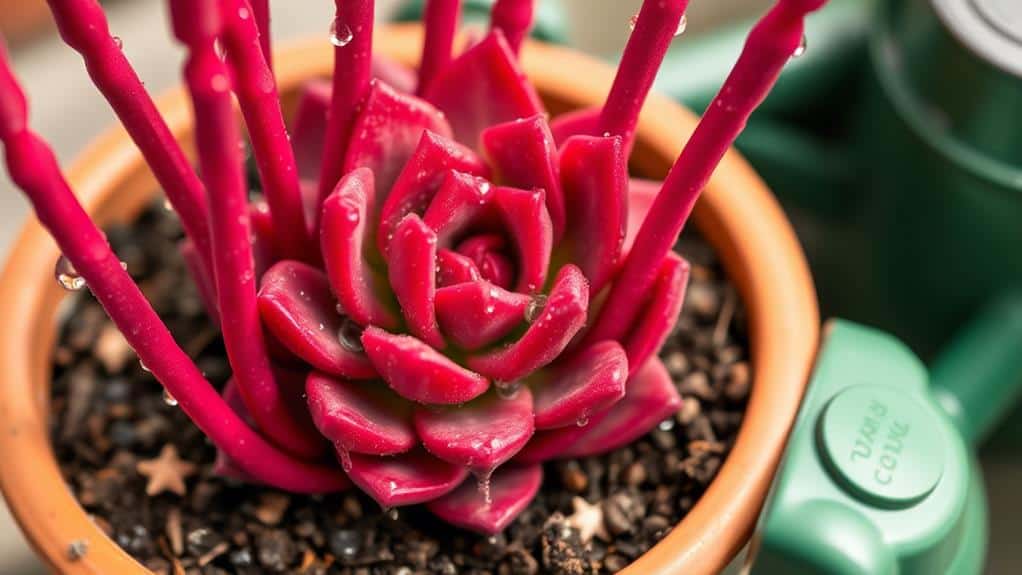
When it comes to watering your Ruby Necklace succulent, it's important to get the timing just right.
I recommend watering thoroughly but infrequently, letting the soil dry out completely between waterings to prevent root rot.
During the growing season, aim for every 2-3 weeks, and always check the soil moisture by inserting your finger about two inches deep.
Proper Watering Frequency
Watering a Ruby Necklace succulent properly is essential for its health and vibrancy. You should water the plant thoroughly but infrequently, typically every 2-3 weeks.
It's important to let the soil dry out completely between waterings. Overwatering can lead to root rot, so make sure excess water drains from the pot.
During winter, reduce your watering frequency, as the plant needs less moisture while dormant. Always use room temperature water to avoid shocking the plant.
Soil Moisture Check
Checking the soil moisture of your Ruby Necklace succulent is essential for maintaining its health. I always do a soil moisture check by inserting my finger about two inches deep. If it feels dry, it's time to water thoroughly.
Make sure the excess water drains completely to prevent root rot. Let the soil dry out between watering, usually every 2-3 weeks.
Keep an eye out for yellowing leaves, which can be a sign of overwatering. This plant prefers to dry out between watering sessions. If you notice yellow leaves, you might need to reduce watering frequency.
Seasonal Water Adjustments
Understanding soil moisture is just one part of keeping your Ruby Necklace succulent happy; adjusting watering routines according to the season is equally important.
During the spring and fall, water your succulent about once per week, making sure the soil is completely dry between sessions. In winter, reduce the watering frequency to every 2-3 weeks since the plant's growth slows.
Overwatering can cause root rot, so always let the soil dry out fully before watering again. During the hot summer months, if your plant is in a shaded area, keep a close eye on the soil moisture and modify as needed to prevent it from drying out.
Remember to use room temperature water and guarantee your pot has drainage holes for proper soil moisture management.
Soil and Potting Needs
For a Ruby Necklace succulent to thrive, you've got to focus on its soil and potting needs. These plants love well-draining, acidic soil, ideally with a pH of 6.0-6.5. You can go for commercial cactus and succulent mixes, as they're perfect.
If you prefer a homemade option, mix potting soil, perlite, and sand.
To guarantee your succulent stays happy, remember these tips:
- Use a pot with drainage holes.
- Choose terracotta pots to help regulate moisture.
- Plan on repotting every 1-2 years to refresh the soil.
These steps help prevent root rot and give your Ruby Necklace plenty of room to grow.
Stick to these guidelines, and your plant will flourish!
Temperature and Humidity

Now, let's talk about the ideal temperature and humidity for your Ruby Necklace succulent.
These plants thrive best in temperatures between 60°F and 80°F and prefer humidity levels from 30% to 50%.
Make sure to keep them away from cold drafts and heat sources to avoid stress and damage.
Ideal Temperature Range
When it comes to caring for a Ruby Necklace succulent, guaranteeing the right temperature and humidity is key to its thriving. The ideal temperature range for this plant is between 60°F to 80°F. Keeping it within this range helps prevent stress and promotes healthy growth.
To maintain a stable environment, remember to:
- Avoid exposing the plant to cold drafts or heat sources.
- Guarantee it's not placed near cold or drafty windows during winter.
- Maintain consistent humidity levels between 30% to 50%.
Humidity Preferences
Humidity plays an essential role in the well-being of your Ruby Necklace succulent. These plants thrive in low to moderate humidity levels, ideally between 30-50%, which makes them perfect for typical household environments.
Maintaining proper humidity and temperature, between 60-80°F (15-27°C), helps prevent stress on your succulent, like leaf drop or pest infestations. Avoid placing them near cold drafts or heat sources to prevent temperature fluctuations.
In overly humid conditions, there's a higher risk of fungal infections. To combat this, guarantee good air circulation around the plant.
Proper humidity and air movement keep your Ruby Necklace happy and healthy. Remember, maintaining these conditions is vital for the plant's overall well-being, helping it thrive in your home.
Seasonal Adjustments
As seasons change, so do the needs of your Ruby Necklace succulent, especially regarding temperature and humidity.
This plant thrives in temperatures between 65°F and 80°F, but it must be shielded from temperatures below 50°F. During warmer months, keep humidity levels between 30-50% and avoid very dry or overly humid conditions.
When winter arrives, the plant enters dormancy. Reduce water frequency and guarantee it's in a warm, draft-free spot to prevent cold stress.
Seasonal changes also affect light exposure; providing afternoon shade during summer can protect it from scorching.
Regularly monitor:
- Temperature fluctuations
- Humidity levels
- Light exposure
These adjustments will help your Ruby Necklace succulent flourish through each season.
Fertilization
Fertilizing your Ruby Necklace succulent is essential for its healthy growth, especially during its active growing seasons in spring and summer.
I recommend using a low-nitrogen cactus or succulent fertilizer diluted to half strength every 4-6 weeks. This helps promote healthy growth without overwhelming the plant.
During the dormant period in summer and winter, avoid fertilizing as the plant doesn't need extra nutrients.
Stick to a balanced fertilizer with an N-P-K ratio of 10-10-10 or similar. Be cautious of excessive fertilization; it can cause lush growth that might harm the plant's structure and increase pest problems.
Monitor your plant for signs of leaf burn or discoloration. If you see any, reduce the frequency or concentration of the fertilizer.
Propagation Techniques
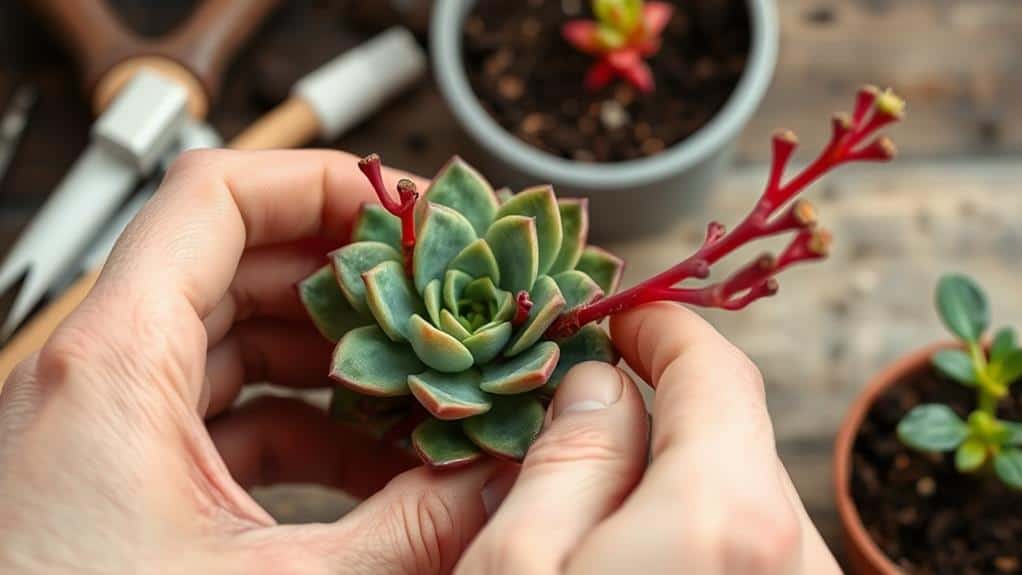
When propagating a Ruby Necklace succulent, start by taking 3-4 inch stem cuttings with at least one node.
Place the cuttings in a dry spot for a few days to let them callous, then plant them in well-draining soil.
Keep the soil slightly moist and place the cuttings in bright, indirect light to help them root successfully.
Ideal Cutting Length
To propagate a Ruby Necklace succulent successfully, cut healthy stems into segments about 3-4 inches long. Each cutting should have at least one node; this is essential for root development during propagation.
After cutting, let the cuttings callous for 2-3 days in a dry place to prevent rot.
When planting the cuttings, use a well-draining soil mix, like a blend of succulent soil and perlite. This promotes healthy root growth.
- Allow cuttings to callous for 2-3 days.
- Use a well-draining soil mix.
- Water sparingly, keeping soil slightly moist.
Keep the soil slightly moist until roots establish, typically in 2-3 weeks. This will set the stage for a thriving Ruby Necklace succulent.
Happy gardening!
Rooting Environment Tips
For a successful propagation of your Ruby Necklace succulent, it's crucial to create the right rooting environment.
Start with 3-4 inch stem cuttings and let them callous for a few days. Plant the cuttings in well-draining soil, ensuring at least one node is submerged.
Keep the soil slightly moist until roots establish, usually in 2-3 weeks. Place the cuttings in bright indirect light, with some direct sunlight to encourage robust growth.
Maintain temperatures above 65°F to promote healthy root growth. Check the cuttings regularly for signs of rot or stress.
Make sure the soil dries out completely between waterings to avoid excessive moisture, which can lead to rot. Following these rooting environment tips will help your Ruby Necklace thrive!
Pruning and Maintenance
As your Ruby Necklace succulent starts to grow, pruning becomes essential for keeping it in top shape. Regular maintenance helps promote healthy regrowth and keeps the plant looking its best.
Use clean, sharp scissors or pruning shears to trim back stems, cutting just above a leaf node. This encourages bushier growth and maintains its beautiful trailing appearance.
Don't forget to remove any dead leaves to improve airflow and reduce the risk of pests.
- Trim dense areas to achieve a balanced shape.
- Allow cuttings to callous for a few days before replanting in well-draining soil for successful propagation.
- Regularly inspect for uneven growth patterns.
Common Pests and Diseases
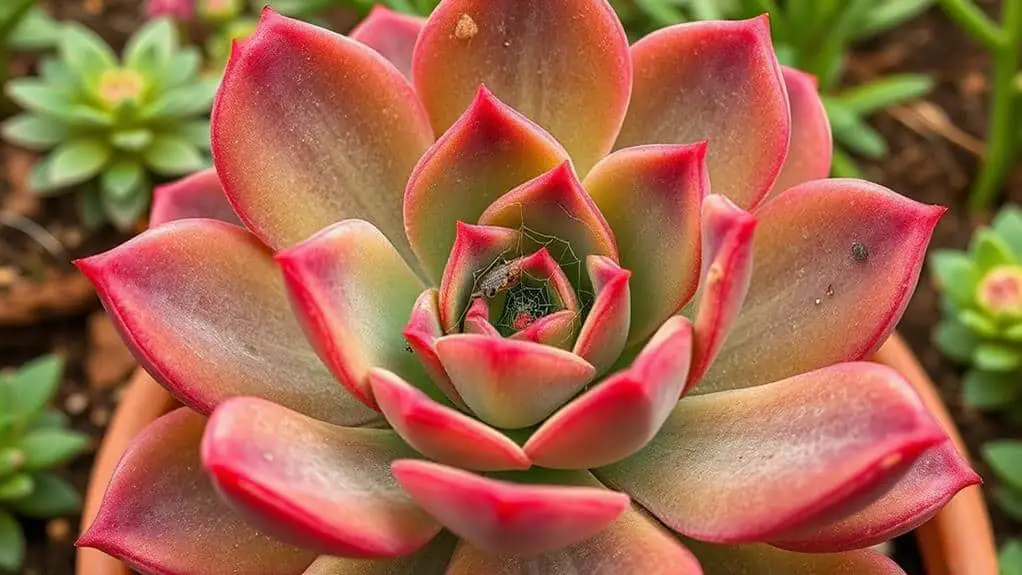
After ensuring your Ruby Necklace succulent is pruned and maintained properly, it's important to stay vigilant about common pests and diseases that could affect it.
Regularly inspect the leaves and stems for mealybugs, spider mites, and aphids. These common pests can weaken your plant and cause leaf damage. Look for webbing or sticky residue as telltale signs.
Overwatering can lead to fungal diseases like root rot and yellowing leaves. To prevent this, use well-draining soil and avoid excessive watering.
If pests appear, treat the affected areas with insecticidal soap, rubbing alcohol, or neem oil. Ensuring good air circulation also helps keep pests and diseases at bay.
Troubleshooting Common Issues
Troubleshooting common issues with your Ruby Necklace succulent can be straightforward if you know what to look for. Overwatering is the most common problem. Always let the soil dry out completely between waterings to prevent root rot.
Leaf drop or yellowing often signals environmental stress, usually from insufficient light or inconsistent watering. Adjusting these factors can revive your plant.
Leggy growth indicates it's not getting enough light; move it to a spot with bright, indirect sunlight.
Keep an eye out for:
- Pests: Mealybugs and spider mites can be managed with neem oil or insecticidal soap.
- Browning leaf tips: This usually means underwatering; check soil moisture regularly.
- Leggy leaves: Ascertain your plant gets enough light to prevent stretching.
Frequently Asked Questions
How to Care for Ruby Necklace Succulent?
To care for your Ruby Necklace succulent, guarantee a proper watering schedule, provide adequate light requirements, and use the right soil type. Regularly check for pests and manage temperature preferences. Propagation methods and common diseases are also essential considerations.
How to Take Care of a Ruby Necklace?
To take care of a ruby necklace, I guarantee it gets bright sunlight, follow a 2-3 week watering schedule, use well-draining soil, control pests, maintain 60-80°F temperatures, and occasionally fertilize. Propagation methods are also essential.
Why Is My Ruby Necklace Plant Dying?
I think your Ruby Necklace plant might be dying due to overwatering signs like root rot, pest infestations, or poor soil drainage. Check its temperature sensitivity, light requirements, fertilizer options, and consider pruning techniques to help it recover.
How to Get a Ruby Necklace to Turn Red?
To get a Ruby Necklace to turn red, I guarantee it has proper sunlight exposure and monitor soil moisture. I also keep temperatures within its preferences. Adjusting pruning techniques, fertilizer types, pest management, and propagation methods helps too.
Conclusion
Taking care of a Ruby Necklace succulent is easier than you might think. Just remember to give it plenty of sunlight, water it correctly, and use the right soil. Keep an eye on the temperature and watch out for pests. With a bit of attention and love, your succulent will thrive. Don't worry if you're new to gardening; you've got this! Enjoy the process and watch your Ruby Necklace flourish. Happy gardening!

